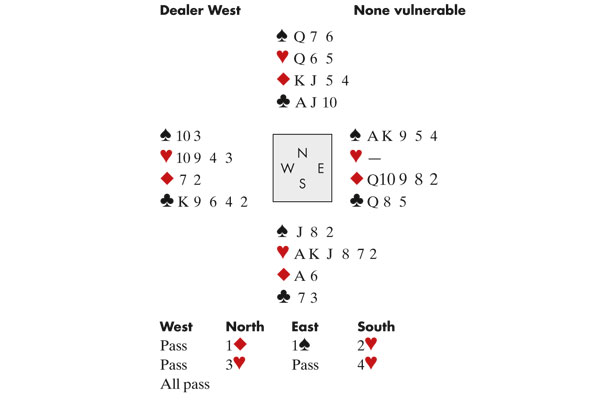Once you’ve made a fool of yourself in public often enough, you pretty much stop minding. At least, that’s my experience of playing bridge on Vugraph (which is broadcast online, for all to watch). These days, all major national and international tournaments are shown online, so there’s no getting away from it; but you quickly learn that every player — even the best — makes blunders under pressure.
That’s my excuse, anyway — in case you saw any of the action from the England women’s bridge trials last weekend. I was lucky enough to be partnering Sally Brock, so despite some egregious mistakes we finished second (Jane Moore and Gillian Fawcett won — they always do), which means we’ll be representing England in the Lady Milne (Home Internationals) next April.
Kitty Teltscher, one of the trialists, just missed out on a qualifying place, but surely gets the prize for the best played hand:
3NT is the place to be — but most pairs were in 4♥. West led the ♠10. Clearly, the play is going to go: ♠K, ♠A, ruff. After which, you’ll probably have to resort to a diamond finesse to get rid of a club. Every declarer went down — bar Kitty. Kitty managed to enlist the opponents’ help with a dazzlingly imaginative manoeuvre. She covered the opening ♠10 with dummy’s ♠Q. West won with the ♠K and cashed the ♠A — under which Kitty played her ♠J! Suddenly, East’s ♠9 was good: she cashed it, and West, seeing no need to ruff, discarded the ♦7. And now? Just as Kitty had hoped, East switched to a diamond – right into dummy’s tenace. Perhaps West should have known to ruff the third spade and play a minor suit — but ruffing partner’s winner never feels natural, especially when you might be squandering a possible trump trick.







Comments
Join the debate for just $5 for 3 months
Be part of the conversation with other Spectator readers by getting your first three months for $5.
UNLOCK ACCESS Just $5 for 3 monthsAlready a subscriber? Log in